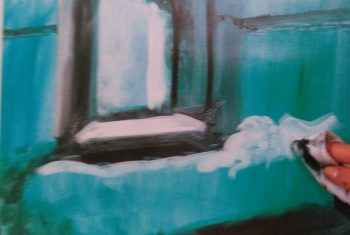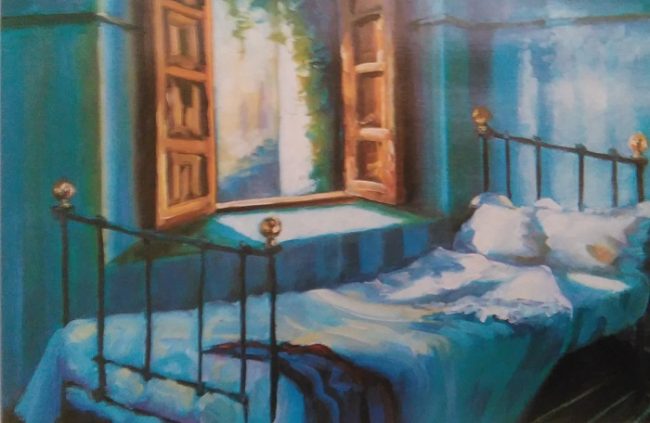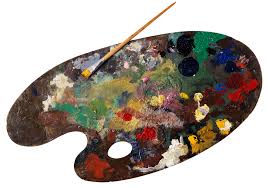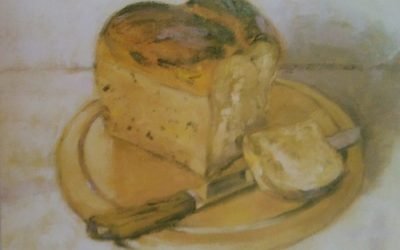The usual way to start an oil painting is to cover the main shapes, mass and tone of the composition with a diluted neutral color before you add main details and surface colors and textures. Before you start painting you should create an image of how the painting will look like when finished.
Composition, drawing, proportion-all elements can change easily in the first stadium of painting. Oil painting underpainting is very important since all the mistakes can be corrected in this stadium of painting.
For underpainting, you use very diluted paint which allows you to simply erase it with a rag soaked with mineral spirits. When you start adding the second layer of paint that won’t be possible since then you will use thicker paint and there is a high possibility you will smear everything and smudge the colors if you start correcting something.
When you are doing underpainting always have in mind one thing the first layer of paint has to be diluted only with mineral spirits no oils. When the first layer is fully dry then, and only then you can add additional layers.
To save time it is best that you use the colors that dry quickly like Raw brown, Cobalt Blue and Earth Green.

Bedroom
It is very important determining dark and bright tones in this composition in order to create the impression of flickering light. Starting with underpainting the artist was able to control the tone balance on the painting not letting the colors to confuse him. Colors used for underpainting are blue-grey tones so they would be in balance with cold shady areas of the bedroom.
To create a painting like this you will need:
- Primmed canvas
- Flat synthetic bristle brush 15mm wide
- Flat synthetic bristle brush number 4
- Flat synthetic brush number 6
- HB pencil
- Odourless mineral spirits
- Napkin
- Small piece of muslin
You will need the following colors:
- Phthalo Turquoise
- Phthalo Blue
- French Ultramarine
- Indigo
- Windsor Purple
- Raw Brown
- Burnt Sienna
- Brown Ochre
- Ochre Yellow
- Lemon Yellow
- Red
- Titanium White
When you are painting a complexed subject it is best that you make a sketch of it using a pencil. Use the sketch to check the perspective details and layout of light and dark tones. Draw a grid over your sketch to make transferring it on the canvas easier. Draw a grid of the same proportions on the canvas and then transfer each part of your sketch to it.

Sketching
Mix a thin solution of Phthalo Blue and apply it to the canvas using flat 199mm brush.
Add just a little bit of Indigo to the mixture and mark the dark tones such as window frame, corners of the room and the shadows surrounding the bed.
Wrap a piece of muslin around your finger and dip it into mineral spirits use it to wipe off the wet paint until you see the whiteness of the canvas in order to introduce the lightest areas of the painting like those on the window and bed.
Using the edge of flat brush number 4 paint the lines on the window and metal parts of the bed with the mixture of Phthalo Turquoise and Indigo. Completely finish underpainting by adding details to the window and sides of the bed. Start determining the shapes of light and shadow on the sheets and the robe placed on the bed.
Add some more indigo to the mixture and paint the ivy o the window. Use a piece of muslin soaked in mineral spirits to point out the ridges on the bed sheets and the pillows.
Once you are done underpainting you can start adding the details. To create a nice surface to paint on try the following technique: take a napkin and place it carefully on the painting, gently press it to get the surface to pick up all the redundant paint and very carefully remove it.
You will notice that the surface is now much nicer to paint on. Main texture is preserved but the colors are lighter and softer which makes it easier for you to add the details.

Adding The Details
Start adding warm tones into the room. Partially mix Titanium White, Windsor Purple Brown Ochre. Use flat brush number 4 to sketch the scenery you can see out the window. Paint with relaxed fluid brushstrokes adding paint wet on wet.
Use pure white to paint the lightest areas on the wall. Add warm enlightened areas on the leaves using a mixture of white and a tiny bit of Ochre Yellow.
For the leaves in the shadow use Phtahlo Turquoise and Phthalo Blue. Paint the wooden shutters with very thin spread or Burnt Sienna and with Brown Ochre paint the balls on the sides of the bed. To make an impression of depth on the scenery that is visible outside the window make the details that point out and the color on the window darker.
Cover the shutters with the mixture of indigo and Raw Brown. Mix Ochre Yellow, Burnt Sienna and white to paint fine carvings on the wood. On the areas where warm sunlight shines on the edges of the shutters use warm orange mixed with red, Ochre Yellow and Lemon Yellow. For colder reflections add spots of white and Lemon Yellow.
Paint the shadows that shutters cast to the window frame usingPhthalo Turquoise and Indigo. Sunlight that comes through the open window gives the shadows on the wall bright blue-purple tone. Use flat brush number 6 to paint the walls with Phthalo Turquoise and white adding a bit Windsor Purple for shaded areas.

For the shadow on the wall next to the window mix Indigo and Windsor Purple. paint the window frame with a mixture of Phthalo Blue, white and just a tiny bit of ultramarine.
Paint the bars with rough moves using indigo and Raw Brown and additionally work on the wall that is framing the window using white and Lemon Yellow. Soften the color on the wall on the right using a mixture of ultramarine and white.
Refine the shadows under the bed using Indigo wit a little Raw Brown added to it then use the brush handle to draw the lines in wet paint in order to depict floorboards.
Using brush number 4 refine metal sides of the bed with indigo.Mix Lemon Yellow with a bit of red and add it to the brightest areas on the brass balls on the bed.
Finishing Touches
Start refining cold shadows and warm light areas on white bedsheets. Go over the shadows that you determined with underpainting with nuances of ultramarine and Phthalo Blue. On the areas where the sheets fall over the sides of the bed shadows are more purple. Paint those areas with a mixture of Windsor purple and white.
Mix white and ochre yellow to add light areas to the pillows and the sheets. Paint the striped pattern on the robe using red and a mixture of Phthalo Blue and white. Work on the sides of the bed using indigo and finish brass balls on the bed using Raw Brown for the shadows, red for the reflections and Lemon Yellow for the brightest areas on them.
Make the shadow on the sheets that fall over the edge of the bed darker using a mixture of ultramarine, white and Windsor Purple. Mix white with a small amount of ultramarine and paint light areas on the sheets where the sun is shining directly on the bedsheets.
Use the same mixture to paint the pillows and depict their wrinkled edges and then soften and blend shadows and lighter areas on the right wall. In the end, use dots of pure white to depict colorful light coming through the window across the window frame and bedsheets.





0 Comments